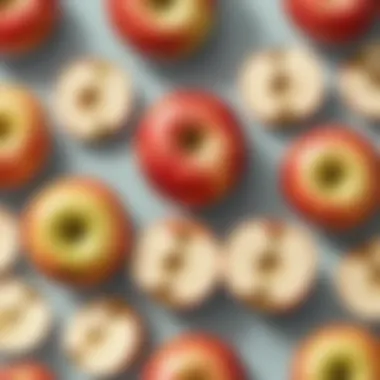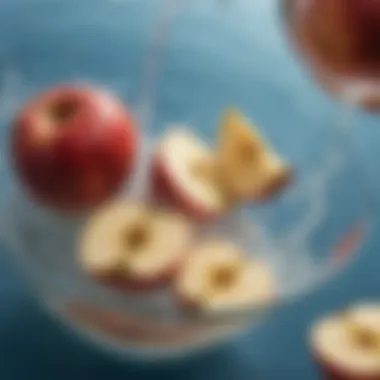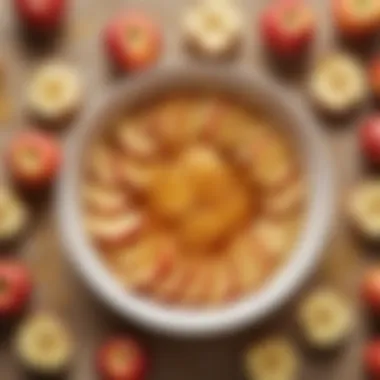How to Prevent Apples from Browning: Proven Methods Revealed


Science Fun Facts
Apples are a fascinating fruit with a unique characteristic: they tend to turn brown when exposed to air. This process, known as oxidation, occurs due to an enzyme called polyphenol oxidase reacting with oxygen in the air. If you cut open an apple and leave it on the counter, you might notice it turning brown over time. But don't worry, there are ways to prevent this natural discoloration and keep your apples looking fresh and appetizing!
Discover the Wonders of Science
When it comes to understanding why apples turn brown, exploring the science behind it can be both enlightening and engaging. By delving into the chemical reactions happening at a microscopic level, children can discover the magic of how substances interact and change properties. Educational videos and animations can help illustrate these concepts, making learning not only informative but also visually stimulating. Real-life applications of science, such as food preservation techniques, showcase how scientific knowledge can be utilized in everyday scenarios for practical benefits.
Science Quiz Time
To test your knowledge on apple oxidation and preservation, interactive quizzes can provide a fun and educational activity. Multiple-choice questions can challenge children to think critically about the reasons behind apples turning brown and the methods to prevent it. Brain teasers and puzzles related to food science can enhance cognitive skills while fostering an interest in the scientific principles governing our food. Learning through gamification can make the learning process enjoyable and memorable, encouraging children to retain information through playful engagement.
Science Experiment Showcase
Engaging in hands-on experiments is a fantastic way to deepen understanding and learning retention. By following step-by-step instructions, children can conduct experiments to witness firsthand how different preservation methods affect the browning of apples. Providing a materials list ensures that all necessary components are readily available for a seamless experiment. Safety tips and precautions are crucial to instill responsible scientific practices, teaching children the importance of safety measures in any scientific endeavor. Through these experiments, young minds can not only prevent apples from turning brown but also gain a profound appreciation for the wonders of science.
Understanding the Science behind Apple Browning
Understanding the intricate process of apple browning is crucial in preserving the freshness and visual appeal of this ubiquitous fruit. By delving into the enzymatic reactions that lead to discoloration, we can uncover effective methods to prevent this natural occurrence. Pioneering through the complexities of enzymatic browning enhances our appreciation for the biochemistry at play in everyday fruits, offering a deeper connection to the food we consume.
Enzymatic Browning Process
Impact of Polyphenol Oxidase


Exploring the impact of polyphenol oxidase in apples sheds light on its pivotal role in catalyzing the browning process. This key enzyme initiates the oxidation of phenolic compounds within the fruit, leading to the formation of highly reactive quinones. Despite its reputation for causing undesired discoloration, polyphenol oxidase stands as a significant player in the dynamic biochemistry of apple browning, necessitating strategic approaches to inhibit its activity.
Role of Oxygen in Browning
Oxygen serves as a dual-edged sword in the browning of apples, acting both as a necessary substrate for enzymatic reactions and as a catalyst for the undesirable discoloration process. By understanding the delicate balance oxygen maintains in apple physiology, we can implement targeted interventions to minimize its impact on browning. Properly managing the presence of oxygen within apple tissue proves instrumental in prolonging the fruit's freshness and visual appeal.
Factors Influencing Apple Browning
Exposure to Air
The exposure of apple flesh to ambient air engenders a series of biochemical reactions that culminate in the unsightly browning phenomenon. This interaction between oxygen and enzymes within the fruit triggers the oxidation of polyphenols, hastening the deterioration of apple quality. Mitigating the effects of air exposure through rapid consumption or protective treatments emerges as a critical strategy in preserving the pristine appearance of freshly cut apples.
Bruising and Cutting
The mechanical stresses induced by bruising and cutting disrupt the cellular integrity of apples, accelerating the release and interaction of browning-related enzymes and substrates. By recognizing the significance of minimal tissue damage in mitigating enzymatic browning, individuals can adopt careful handling practices to sustain the visual allure of apple slices or wedges. A heightened sensitivity to the vulnerability of bruised or cut surfaces serves as a cornerstone in minimizing the progression of undesirable discoloration.
Enzyme Activation
Enzyme activation within apples signifies a pivotal juncture in the onset of browning, precipitated by physical disruption or exposure to oxidative environments. The awakening of dormant enzymes like polyphenol oxidase catalyzes the oxidation of phenolic compounds, hastening the discoloration of apple flesh. Unveiling the triggers and implications of enzyme activation empowers individuals with the knowledge needed to preemptively counteract browning processes and uphold the visual integrity of fresh apple preparations.
Methods to Prevent Apple Browning
In this section, we delve into the critical topic of preventing apple browning. Maintaining the freshness and visual appeal of apples is a paramount concern for many. By understanding and implementing effective methods, one can prolong the quality of this beloved fruit. Exploring various techniques to inhibit browning not only enhances the aesthetic value of apples but also ensures their nutritional integrity remains intact. The significance of this section lies in its practicality and relevance to individuals seeking ways to preserve apples efficiently.
Acidic Solutions


Lemon Juice
When it comes to combating apple browning, lemon juice emerges as a key player in the arsenal of preventative measures. The high acidic content of lemon juice acts as a natural barrier against enzymatic browning, keeping the apple flesh looking fresh and appealing. Its citric nature disrupts the oxidation process, thereby preserving the apple's color and texture. A prime choice for many, lemon juice's versatility and accessibility make it a popular selection for preventing browning in various culinary applications. Despite its effectiveness, one should be mindful of using excessive amounts of lemon juice, as it can impart a tangy flavor to the apples, potentially altering their taste profile.
Vinegar
Another acidic contender in the fight against apple browning is vinegar. With its acetic properties, vinegar serves as a reliable solution to halt enzymatic browning. The acidic environment created by vinegar hinders the activity of polyphenol oxidase, the enzyme responsible for browning reactions. This simple yet powerful ingredient offers a practical and economical way to preserve the appearance of apples. However, it is crucial to dilute vinegar appropriately to avoid imparting an overly strong taste to the fruit. Finding the right balance is essential to ensure the apples retain their natural flavor while benefiting from the protective shield provided by vinegar.
Saltwater Solution
Concentration and Soaking Time
Delving into the realm of saltwater solutions, we encounter a unique method for preventing apple browning. The combination of salt and water creates a saline environment that inhibits enzymatic browning by altering the pH level on the apple's surface. Adjusting the concentration of salt and the duration of soaking time can influence the effectiveness of this solution. While saltwater offers an alternative to acidic treatments, it is important to strike a balance in the solution's strength. Excessive salinity can detrimentally affect the taste of the apples, emphasizing the need for precise measurements and controlled soaking periods.
Temperature Control
Refrigeration
One of the simplest yet most effective methods of preserving apples is through refrigeration. Maintaining apples at low temperatures slows down the enzymatic reactions that lead to browning. Refrigeration not only extends the shelf life of apples but also helps retain their crispness and flavor. By storing apples in the refrigerator, individuals can enjoy fresh and vibrant fruit for a longer duration. While refrigeration is a convenient way to prevent browning, it is essential to avoid placing apples near strong-smelling foods, as they can absorb odors easily.
Blanching
A lesser-known technique in apple preservation, blanching involves briefly immersing apples in hot water before cooling them rapidly. This process helps deactivate enzymes that trigger browning, maintaining the apple's visual appeal. Blanching also aids in loosening the skin, making it easier to peel apples for various culinary preparations. While blanching is effective in inhibiting browning, it is important to handle the blanching process with care to prevent overcooking or affecting the apple's texture adversely.
Protective Coatings


Honey
In the realm of protective coatings, honey stands out as a natural and versatile option for preserving apples. The sticky consistency of honey creates a barrier between the apple's flesh and the surrounding air, preventing oxidation and browning. Apart from its protective properties, honey adds a hint of sweetness to the fruit, enhancing its overall taste profile. As a natural alternative to traditional methods, honey offers a holistic approach to apple preservation, catering to individuals seeking organic solutions to extend the freshness of their fruit.
Sugar Syrup
Among the array of protective coatings, sugar syrup emerges as a classic choice for inhibiting apple browning. The viscous nature of sugar syrup forms a protective seal around the apple, preventing exposure to oxygen and subsequent discoloration. Sugar's ability to disrupt the enzymatic browning process makes sugar syrup a preferred option for preserving the visual appeal of apples. It is essential to coat the apples evenly with sugar syrup and control the thickness of the layer to ensure optimal preservation without overpowering the apple's natural flavor.
Vacuum Sealing
Role in Preventing Oxygen Exposure
Venturing into the domain of vacuum sealing, we encounter a modern approach to preventing apple browning. Vacuum sealing involves removing air from the packaging to create a controlled environment that limits oxygen exposure, thereby slowing down the oxidation process. By eliminating the oxygen supply, vacuum sealing offers a protective barrier that preserves the freshness and color of apples for an extended period. While vacuum sealing effectively inhibits browning, it is essential to follow proper sealing techniques to ensure airtight conditions, maximizing the longevity of the apples' quality.
Additional Tips for Keeping Apples Fresh
In this comprehensive guide on preventing apples from turning brown, it is crucial to delve into additional tips that play a pivotal role in maintaining the freshness and quality of the fruit. Proper storage techniques are essential to prolong the shelf life of apples and ensure they remain visually appealing. These tips provide valuable insights for individuals looking to preserve their apples effectively. By understanding the significance of optimal storage, one can enjoy apples at their peak quality.
Proper Storage Techniques
Use of Airtight Containers
Discussing the importance of utilizing airtight containers to store apples is imperative in this context. Airtight containers offer a secure environment that minimizes exposure to air, thereby reducing the chances of enzymatic browning. The key characteristic of airtight containers is their ability to seal tightly, preventing external air from interacting with the fruit. This feature is highly beneficial in maintaining the freshness of apples for extended periods. Although airtight containers are a popular choice for storing fruits like apples, it is important to note that their seal should be intact to ensure maximum effectiveness. The unique aspect of airtight containers lies in their ability to create a controlled environment that inhibits browning reactions, thus preserving the visual appeal of the fruit.
Avoiding Overcrowding
When discussing proper storage techniques for apples, it is essential to address the issue of overcrowding. Overcrowding apples in storage can lead to bruising and accelerated browning due to increased physical contact between the fruits. Avoiding overcrowding ensures that each apple has sufficient space around it, reducing the risk of damage and premature browning. The key characteristic of avoiding overcrowding is to maintain proper air circulation between the apples, preventing the buildup of ethylene gas that accelerates ripening and browning processes. This practice is beneficial as it helps in preserving the individual integrity of each fruit, contributing to prolonged freshness and visual appeal. However, it is important to strike a balance and not underutilize the storage space, ensuring efficient use while safeguarding the quality of the apples.
Immediate Consumption
In the context of preserving apple freshness, the concept of immediate consumption comes into focus as a relevant strategy. Preventing browning upon cutting is a key aspect of ensuring that freshly cut apples retain their visual appeal and taste. By addressing this aspect proactively, individuals can enjoy sliced apples without compromising on their quality. The key characteristic of preventing browning upon cutting is the application of techniques such as lemon juice or other acidic solutions to inhibit enzymatic browning. These solutions act as protective barriers, delaying the oxidation process and preserving the natural color of the fruit. The unique feature of this approach lies in its simplicity and effectiveness in maintaining the freshness of apples, making them more enticing for immediate consumption. While this method offers significant advantages in keeping apples visually appealing, it is essential to consume the fruit promptly to fully benefit from its freshness and nutritional value.







